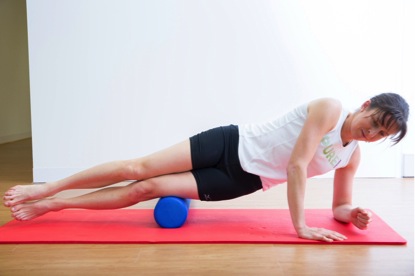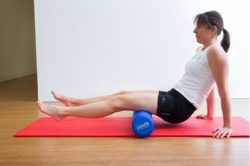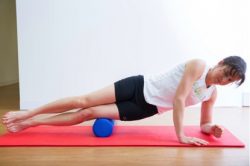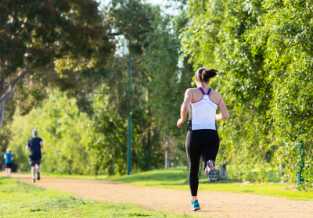Pull Out Your Foam Roller Before You ‘Run For The Kids’ On March 22nd!
Published on
11 Mar 2015

Call us on: (03) 9975 4133
Physiotherapist Emma Lee shows you how to self-release tight muscles using a foam roller!
You may or may not be familiar with the Foam Roller – a cylindrical piece of hard foam that can be used to ‘roll out’ or release the fascia or connective tissue that encompasses our muscles.
Foam Rolling is a great way for runners to self-manage muscle and fascial tightness, and it can target many of the major muscle groups that tend to become tight and restricted. The beauty of foam rolling is that you use your body weight to provide pressure so you can do it yourself at home or at the gym. If an area is particularly painful or tight, you can be more gentle and support your weight elsewhere. On the other hand, you can add more of your body weight onto the roller to provide a stronger release or as you become less sensitive.
How does it work?
Foam Rolling is a form of self-myofascial release (connective tissue release) that is often used before and/or after exercise, or to assist with injury management as an adjunct to manual treatment.
There is evidence to show that using the foam roller can:
– Help to reduce muscle soreness or Delayed Onset Muscle Soreness (DOMS) during the 48 hours following strenuous exercise.
– Help to increase short term and long term flexibility
Where do I use it?
This will depend on the individual and will be focussed on areas of tightness or stiffness. Common areas for runners to foam roll are:
Iliotibial Band (ITB):
Anterior (front) knee pain is common in runners, and this is often caused by mal-tracking of the knee cap (patella), which in turn is caused by tightness of the ITB muscle on the side of the thigh and weakness of the inner thigh muscle.
Part of the treatment of this condition is releasing the ITB muscle, which can be done through various manual therapy techniques ie Dry Needling, Massage, Trigger Point Release and Foam Roller release.
If you are experiencing knee pain, it is important to have your knee assessed by a Physiotherapist so that you are diagnosed correctly and provided with an appropriate Treatment and Rehab program. However, using the foam roller as an adjunct to treatment is a great way of self-managing this pain, keeping your ITB muscle nice and loose, and keeping you a happy painfree Runner!
Thoracic Spine (Mid Back):
We all tend to spend a lot of time sitting these days, particularly if we work in an office. Unfortunately our bodies are not designed to sit all day long, and this results in stiffness in the joints of our mid back and tightness in the muscles and fascia surrounding our spine. Using the foam roller over this area is a great way of maintaining mobility in this region. You can use the roller vertically or horizontally along your spine. Roll up and down slowly and hover or focus on specifically tight areas.
Maintaining mobility in this region is important as a runner as rotational mobility through this region is key for normal running mechanics. Stiffness in this region can lead to compensation through the low back, pelvis and hips which can lead to injury and pain so best to jump on that roller!
Quadriceps (Quads):
 Your quads get quite a workout when running, especially when it comes to hills!
Your quads get quite a workout when running, especially when it comes to hills!
The Quads consists of 4 separate muscles on the front of the thigh that work together as a unit. Focus your rolling on the front, inner and outer part of the thigh muscle to cover all parts of the Quads.
Calf:

Tight calf muscles can be a big issue for runners and can severely affect running mechanics. Roll straight up and down along your calf but remember to angle to the outside (lateral gastroc) and inside (medial gastroc) of your calf muscle depending on where you are feeling tightness.
Gluteals (Glutes):
Your glute muscles should be working hard to stabilise your pelvis and drive your body forwards whilst running. Focus on Foam Rolling the side of the glutes and then working towards the tail bone.
Hamstring:

If you sit for any length of period, you will have the tendency to become tight through your hamstrings as they remain in a shortened position whilst sitting
Roll the hamstring muscle and when you find a painful/tight point maintain the pressure.
Which Foam Roller should I get?
There are a number of different types of foam rollers available including softer/harder, bumpy/smooth and short/long which can sometimes be a bit overwhelming! Here are some pointers when considering which one to buy:
Softer/Harder:
If you are new to using a foam roller, start with a softer one as the hard ones can be quite uncomfortable. That said, you can place a towel over a firm foam roller to start with and then remove it once you are more comfortable.
Bumpy/Smooth:
In most cases, the smooth foam rollers are enough to release the area. However, if you are seeking a really strong or deep fascial release you can use a bumpy roller. Note that they are much more uncomfortable so aren’t ideal for first-timers!
Short/Long:
We recommend purchasing a long foam roller that is approximately 1m in length as it’s much more versatile. A longer roller can be used to release larger muscle groups, roll out both legs at once to save time, and also roll out the spine. The short rollers are great for legs or if you want to take it on holiday in your suitcase with you.
There are good quality and lesser quality rollers out there to suit all budgets. However you will get what you pay for. Cheaper ones will flatten and lose their shape in time, but a good quality roller should last years! You can purchase a foam roller directly at either of the Pure Physio clinics.





